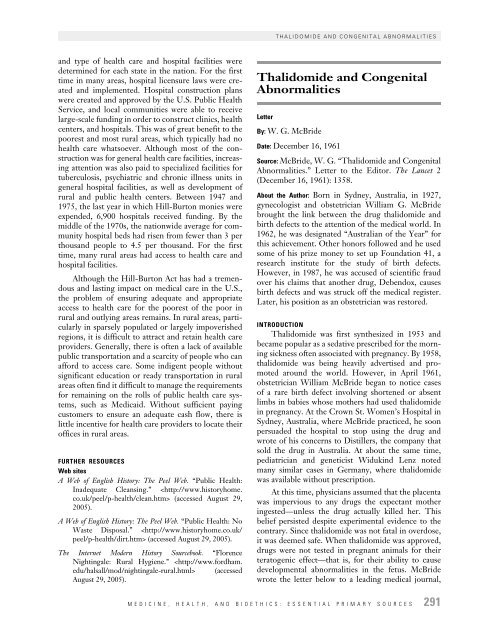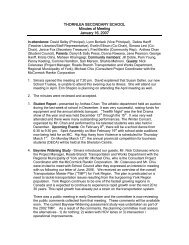Thalidomide and Congenital Abnormalities - Thornlea
Thalidomide and Congenital Abnormalities - Thornlea
Thalidomide and Congenital Abnormalities - Thornlea
Create successful ePaper yourself
Turn your PDF publications into a flip-book with our unique Google optimized e-Paper software.
THALIDOMIDE AND CONGENITAL ABNORMALITIESThe Lancet, to alert the medical community to thedangers of thalidomide.nPRIMARY SOURCETHALIDOMIDE AND CONGENITAL ABNORMALITIESSIR,—<strong>Congenital</strong> abnormalities are present in approximately15% of babies. In recent months I have observedthat the incidence of multiple severe abnormalities inbabies delivered of women who were given the drug thalidomide(‘Distaval’) during pregnancy, as an anti-emetic oras a sedative, to be almost 20%.These abnormalities are present in structures developedfrom mesenchyme—i.e., the bones <strong>and</strong> musculatureof the gut. Bony development seems to be affected in avery striking manner, resulting in polydactyly, syndactyly,<strong>and</strong> failure of development of long bones (abnormally shortfemora <strong>and</strong> radii).Have any of your readers seen similar abnormalities inbabies delivered of women who have taken this drug duringpregnancy?Hurstville, New South Wales.W. G. MCBRIDE.nnnA young thalidomide victim, born without arms, clutches abouquet with her toes as she presents it to Princess Anne ofGreat Britain in 1972. ªBETTMANN/CORBIS.SIGNIFICANCEMcBride’s warning concerning the teratogeniceffects of thalidomide saved countless babies frombeing born with birth defects. However, the drugremained on the market for some time followingMcBride’s warning, which accounts for the fact thatthere are still some 8,000 thalidomide survivors in theworld today.The observations of McBride <strong>and</strong> Lenz were tohave far-reaching effects on the pharmaceutical industry.They were astute enough to notice rare <strong>and</strong> unusualconditions occurring in their patients <strong>and</strong> to spotpatterns <strong>and</strong> connections with factors such as drugexposure. After thalidomide, it became m<strong>and</strong>atory totest new drugs on pregnant animals. Doctors becamefar more aware of the potential teratogenic effect ofdrugs <strong>and</strong> were more careful about the drugs theyprescribed to pregnant women.In general, the drug regulatory authoritiesacquired more sweeping powers after the thalidomidetragedy. One important development was the establishmentof systems for post-market drug surveillance.That is, once a drug is on the market, it is monitoredfor any new side effects that emerge in the generalpopulation. These new side effects are reportedthrough the physician. As a result of these postmarketingsurveillance efforts, several drugs havebeen withdrawn on safety grounds. Unanticipateddrug side effects still occur <strong>and</strong> they still harm oreven kill vulnerable people. However, tighter regulationhas undoubtedly improved patient safety.Meanwhile, thalidomide has enjoyed somethingof a resurgence as a treatment for leprosy <strong>and</strong> multiplemyeloma. However, it is no longer prescribed towomen who are pregnant or who may become pregnant.Scientists now know that other drugs are asdangerous to an unborn child as thalidomide is. Onesuch drug is isotretinoin, which is used in the treatmentof severe acne. A woman actually needs to provideproof of a negative pregnancy test before she canbe prescribed isotretinoin, according to the U.S.Food <strong>and</strong> Drug Administration. While on the drug,she must use an effective method of contraception.The fetus is most vulnerable to medication exposurethrough the placenta in the first three months ofpregnancy. In the thalidomide case, one in fivewomen who had taken the drug between thirtyseven<strong>and</strong> fifty-four days of pregnancy gave birth toa child with birth defects.292 MEDICINE, HEALTH, AND BIOETHICS: ESSENTIAL PRIMARY SOURCES
FAMINE AND PUBLIC HEALTHFURTHER RESOURCESBooksLock, Stephen, John M. Last, <strong>and</strong> George Dunea, eds. TheOxford Illustrated Companion to Medicine. Oxford: OxfordUniversity Press, 2001.Web sitesJames Lind Library.org. ‘‘<strong>Thalidomide</strong>: An UnexpectedAdverse Effect.’’ (accessed November 21,2005.Famine <strong>and</strong> Public HealthPictureBy: DempsterDate: January 21, 1970INTRODUCTIONFamine is the extreme lack of food <strong>and</strong> nutrients,often resulting in widespread disease <strong>and</strong> death. Aparticularly large number of famines occurred duringthe 1900s, <strong>and</strong> into the twenty-first century, despitethe world’s extensive social, economic, <strong>and</strong> technicaladvances during the same time period. Althoughefforts have been made to combat <strong>and</strong> prevent famines,food shortages around the globe, due to such factors aswar, drought, <strong>and</strong> ill-focused political decisions, continueto take a toll on the lives of some of the world’smost impoverished inhabitants.Acute hunger can cause people to die of starvationdirectly, but there are many more individuals who maysurvive famine, only to be faced with the health problemsthat often accompany undernourishment <strong>and</strong>vitamin <strong>and</strong> mineral deficiencies. Common effects ofmalnutrition include stunted growth, weakness, <strong>and</strong>susceptibility to disease. People who are malnourishedoften have poor concentration, which exacerbates theproblem of hunger, as it is difficult for hungry peopleto work in fields, or earn money for buying food.Pregnant women, those who are breast-feeding newborns,<strong>and</strong> children are the most vulnerable to hungerrelated problems. Over 150 million children, worldwide,below the age of five, are said to be underweight.Eleven million children under the age of five die eachyear, with over half of the deaths directly related tomalnutrition. Typically these children do not die fromstarvation itself, but rather from the diseases that strikea weak <strong>and</strong> vulnerable body, whose immune system islikely unable to put up a defense. The four most commonchildhood illnesses in developing countries arediarrhea, respiratory illness, malaria, <strong>and</strong> measles.All parts of the globe are known to have experiencedfamine. The blockade of German trade ships byBritain <strong>and</strong> France, along with a harsh winter in 1916–1917, left several hundred thous<strong>and</strong> Germans deadprior to the start of World War I. Five to eight millionpeople in Ukraine died from famine during the 1930s,when the Soviet Union seized agriculture outputs inhopes of exporting more food to bring in money forindustrialization. The Chinese famine between 1958–1962 is considered one of the worst in history, withestimates of up to thirty million people dying asChina’s leader, Mao Ze-dong, implemented a plan ofrapid industrialization in rural areas.Famines occurring in Africa have received the mostextensive international publicity. During Nigeria’s civilwar with Biafra between 1968–1970, at least one millioncivilians died from hunger <strong>and</strong> fighting. The worldwas shocked by photographs of starving children withdistended stomachs caused by protein deficiency.Between 1984–1985, drought throughout Ethiopiaimpacted 120 million people, with scenes of starvationseen on television sets throughout the western world.Fundraising events all over the world led to the arrivalof some emergency food aid to Ethiopia, but bottlenecksat the ports, <strong>and</strong> poor quality roads slowed downrelief efforts. Throughout the 1990s <strong>and</strong> into thetwenty-first century, civil war between the Arab <strong>and</strong>black Sudanese have led to food crises, particularly inthe Darfur region of Sudan, where 3.4 million, or halfof the region’s population have been forced from theirhomes <strong>and</strong> farml<strong>and</strong>s. Throughout various regions ofAfrica, ongoing political unrest, unreliable rainfall, <strong>and</strong>poverty keep millions of people at risk of hunger.nPRIMARY SOURCEFAMINE AND PUBLIC HEALTHSee primary source image.nnnSIGNIFICANCEThe United Nations (UN) classifies 1.2 billionpeople below the international poverty line, living onless than one dollar per day. Many of these peopleexperience regular food shortages, while others arejust barely able to meet their daily food requirements.All families under the poverty line are vulnerable toshocks such as droughts, earthquakes, <strong>and</strong> wars, allMEDICINE, HEALTH, AND BIOETHICS: ESSENTIAL PRIMARY SOURCES 293
















